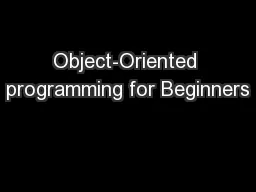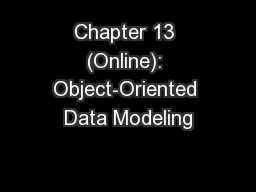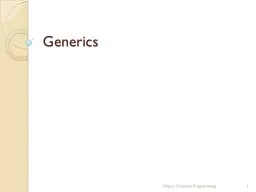PPT-OBJECT-ORIENTED PROGRAMMING
Author : tatiana-dople | Published Date : 2016-07-15
SMALLTALK Lecturers Hesam Setareh Salar Moarref 1 Fall 2009 Programming languages Topics History and Motivation Structural Organization Classes and Subclasses
Presentation Embed Code
Download Presentation
Download Presentation The PPT/PDF document "OBJECT-ORIENTED PROGRAMMING" is the property of its rightful owner. Permission is granted to download and print the materials on this website for personal, non-commercial use only, and to display it on your personal computer provided you do not modify the materials and that you retain all copyright notices contained in the materials. By downloading content from our website, you accept the terms of this agreement.
OBJECT-ORIENTED PROGRAMMING: Transcript
Download Rules Of Document
"OBJECT-ORIENTED PROGRAMMING"The content belongs to its owner. You may download and print it for personal use, without modification, and keep all copyright notices. By downloading, you agree to these terms.
Related Documents





![[PDF]-Python 3 Object-oriented Programming: Building robust and maintainable software](https://thumbs.docslides.com/975150/pdf-python-3-object-oriented-programming-building-robust-and-maintainable-software-with-object-oriented-design-patterns-in-python.jpg)
![[BEST]-Deciphering Object-Oriented Programming with C++: A practical, in-depth guide to](https://thumbs.docslides.com/978939/best-deciphering-object-oriented-programming-with-c-a-practical-in-depth-guide-to-implementing-object-oriented-design-principles-to-create-robust-code.jpg)
![[FREE]-c programming textbook.c programming book.c programming language.c programming.c](https://thumbs.docslides.com/979920/free-c-programming-textbook-c-programming-book-c-programming-language-c-programming-c-programming-visual-quickstart-guide-c-programming-for-dummies-absolute-beginner-s-beginner-exercises-in-easy-steps.jpg)
![[eBOOK]-Programming 19:C Programming Professional Made Easy & Excel Shortcuts (Excel Programming,](https://thumbs.docslides.com/980131/ebook-programming-19-c-programming-professional-made-easy-excel-shortcuts-excel-programming-microsoft-excel-python-for-beginners-c-programming-c-programming-languages-android-c-programming.jpg)
![[BEST]-Programming 11:C Programming Success in a Day & Rails Programming Professional](https://thumbs.docslides.com/980146/best-programming-11-c-programming-success-in-a-day-rails-programming-professional-made-easy-c-programming-c-programming-c-programming-language-rails-android-programming-ruby-rails-php-css.jpg)
![[FREE]-Programming 16: Python Programming In A Day & C Programming Professional Made Easy](https://thumbs.docslides.com/980148/free-programming-16-python-programming-in-a-day-c-programming-professional-made-easy-c-programming-c-programming-c-programming-language-html-python-python-programming-coding-css-java-php.jpg)
![[READ]-Programming 5:C Programming Success in a Day Excel Shortcuts (C Programming, C++programming,](https://thumbs.docslides.com/988966/read-programming-5-c-programming-success-in-a-day-excel-shortcuts-c-programming-c-programming-c-programming-language-excel-javascript-programming-microsoft-excel-python-java-php.jpg)